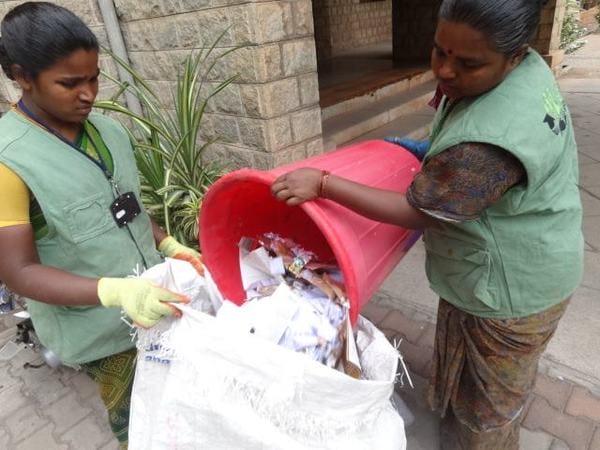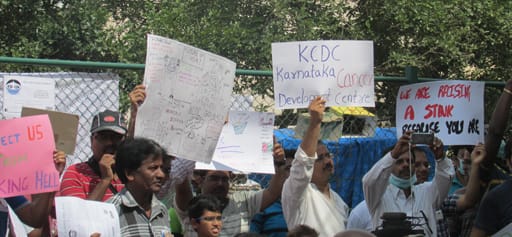Bengaluru is reeling under the severe garbage crisis once again. BBMP and the relevant authorities have failed to address the garbage situation in the city; they have handed over the city and citizens’ health to the garbage mafia. Heaps of garbage are quickly turning into mountains, and an outbreak of an epidemic is inevitable if the apathy and mindlessness continues.
Throwing money at every problem seems to be the only idea BBMP comes up with. Unfortunately, BBMP’s expenditure of over Rs 400-500 crores on Solid Waste Management (SWM) annually has not stopped the garbage crisis. Bengaluru is probably the only city with such high spending on SWM, and it seems like BBMP is busy ‘applying lipstick on a pig’.
Every time there was a garbage crisis, hundreds of truck loads of garbage were sent out to neighbouring villages for dumping, but now with that option ruled out, the streets of Bengaluru are raising the stink.
The villages around Bengaluru have chased out BBMP garbage trucks, after BBMP converted the land near the villages into toxic dump yards and landfills, with absolutely no intention of processing, treating or clearing the garbage. Even the Karnataka Compost Development Corporation (KCDC) that is located in Ward 190 has been opposed to by the ward residents due to faulty policy and contempt of court-ordered Standard Operating Procedures.
People participating in a protest against the KCDC compost unit in October 2015. Pic: Akshatha M
So why is garbage such a big issue for Bengaluru? In simple management terms, it’s ‘Garbage In, Garbage Out’; how can one expect better result from a toothless SWM policy and faulty garbage tender?
Garbage tender should be in sync with the tender policy
A good look at the SWM policy and the garbage tender will not only expose the lack of holistic approach, but the lack of intent. When the garbage tender is not in sync with SWM policy, the policy is designed to fail on all fronts.
The key guidelines of SWM policy that include Source, Collection, Transport, Processing and Disposal should be implemented in totality, but today the policy is gathering dust with no connect to the garbage tender whatsoever.
Source
Segregation at source is the first and crucial step to addressing the garbage crisis; even though currently less than 15% households segregate waste at source, it’s more due to the waste collection method, lack of awareness and lack of sustained localised campaigning in the communities.
Collection and Transport
Even though the tender has certain guidelines on collection, handling and transport, ambiguity in the clauses is completely exploited by the service provider, who have an incentive to transport un-segregated waste. Three critical aspects that need a revamp in the tender are:
-
Shift the policy from collection of segregated waste to collection of the wet and dry waste separately by two different service providers, thereby defining the roles and objectives for the two.
-
Mandatory use of leak-proof containers by all primary collection vehicles, and sync the transfer timings between primary and secondary collection to avoid creating dumping at secondary collection points.
-
Move from the term Treatment to Processing (Composting, Recycling, Reusing)
Processing
The SWM policy has to change from Treatment to Processing, which will lead to reduction in creating newer landfills or dumping yards. Processing should include composting in case of wet waste, recycling in case of dry waste, and reusing to produce energy/bio-gas.
Disposal
Debris and waste that cannot be processed needs a clear destination. There is rampant illegal dumping of the debris on the lake beds and storm water drains across the city. Construction debris is a reality and unless there is a specific destination identified, lakes will suffer at the cost of construction.

Pourakarmikas emptying dry waste into big jumbo bags. Pic: Hasirudala
One does not have to read an encyclopedia to realise that Pourakarmikas (PKs), SHGs and the informal sector of waste-pickers (ISWPs) play a critical role in a successful implementation of SWM policy. PKs, SHGs, ISWPs can be linked directly to various state and central livelihood programs by making them the stakeholders in the SWM policy.
The SWM policy needs a highly decentralised approach. It should emphasise on multiple service providers and SWM Entrepreneurs to create not only competition, but also to push for continuous improvement on a yearly basis in infrastructure and technology.
The State government and BBMP are currently in a ‘frog kissing’ mode; they have announced yet another high cost experiment of Waste-2-Energy plant, but unless the SWM policy and garbage tender are in sync, this will be yet another white elephant, like the Sewage Treatment Plants (STPs) that are running 60-70% below capacity.
A good policy alone cannot guarantee better result, the skill is in implementation. Hence, there is a need to shift focus from spending on tenders to spending on manpower, resources, training, campaigns, awareness programs and an incentive policy.
The Garbage mafia has to end, and to do that, BBMP should start investing on setting objectives, targets and achieving results, and stop throwing taxpayers’ monies on garbage trucks.
Related Articles
Vicious circle of BBMP’s fundcrunch and garbage dumps
Dear city leaders: something is rotting in the city of Bengaluru
Six amazing groups in Bangalore that show how to manage waste in style

It is common knowledge that these same problems exist in Mumbai, Pune, Ahmedabad, … AND LEBANON. So this is a policy implemented with great success throughout the world (or wherever, the policy applies).